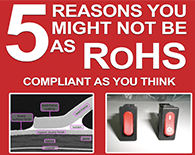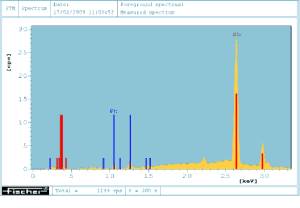Posted By: ITA-Admin | Date: January 14th, 2015

5 Reasons You Might Not be as RoHS Compliant as You Think – RoHS (Restriction of certain Hazardous Substances) was introduced in 2006, and restricts the use of six hazardous substances in electrical and electronic equipment. The substances included are: Lead (PB), Mercury (Hg), Cadmium (Cd), Hexavalent Chromium (CR6+), Polybrominated biphenyls (PBB) and Polybrominated diphenyl ether (PBDE).
 For each substance, there are maximum levels allowed in raw homogeneous materials
For each substance, there are maximum levels allowed in raw homogeneous materials
Although the guidelines are thoroughly documented, companies still make many mistakes that lead to RoHS compliance failure.
RoHS compliance failure can have serious financial consequences for your business. Costs might include delays to product launches, lost sales, additional production costs and re-work costs.
So what are some of these pitfalls, and how can they be avoided? We have identified some common issues and how to steer clear of them.
Hand Soldering
Hand soldering is a common practice amongst electronics manufacturers, particularly for re-working. Hand soldering uses tin/lead solders, which do not comply with the RoHS Directive. Some suppliers either don’t know this or choose to ignore it in the hope they’ll get away with it.
Who’s to blame?
It is a common misconception that ensuring products are RoHS compliant is the responsibility of the supplier, however this is not true. The truth is, it is the responsibility of the OEM or the importer, and they must secure documentation and proof (testing of materials etc) that their components and products adhere to regulations. If procedures to ensure compliance aren’t put in place and rigorously maintained, the costs will fall on the OEM or the importer and it could damage the reputation and future sales of the company.
Exemption
Certain products are exempt from RoHS; for example military and construction products are exempt, as they need to be reliable and strong, whereas lead-free products are weaker. Other products are exempt from lead only, which does not mean they are exempt from RoHS compliance. If a product is lead exempt, it means the material must still not contain higher weights for the remaining five substances listed within the directive.
What’s the difference?
There is a lot of confusion about ‘lead-free’ and ‘RoHS compliant’, leaving some in the dark about whether or not ‘lead-free’ materials are in fact compliant. These two terms are completely different, and should not be treated the same. A material that is lead-free is not necessarily RoHS compliant – all six substances must not be higher than stated, not just lead!
Hidden in plastic
 Many companies are caught out when it comes to polymers, and do not check them for hazardous substances. Flame-retardants used in polymer blends sometimes include PBB and PBDE. Although the plastic itself does not contain these substances, the flame retardant element does, potentially making the product non-compliant. When working with polymers, you must check the compositional make-up of the flame retardant before using it in your plastic products.
Many companies are caught out when it comes to polymers, and do not check them for hazardous substances. Flame-retardants used in polymer blends sometimes include PBB and PBDE. Although the plastic itself does not contain these substances, the flame retardant element does, potentially making the product non-compliant. When working with polymers, you must check the compositional make-up of the flame retardant before using it in your plastic products.
Conclusion
There are various other mistakes that OEMs and suppliers often make whilst trying to ensure their products are RoHS compliant, it is just a matter of ensuring you understand the way the Directive works and testing all materials and components. Hopefully you are now more confident about some of these issues and remember: hand solders typically contain lead, OEMs are always responsible, lead exemption is not RoHS exemption, ‘lead-free’ and ‘RoHS compliant’ are different and flame retardants in plastics need checking.
The best way to ensure success is to provide training for all employees, from purchasing to manufacturing to final assembly. By training staff you will prevent reliability issues and cross contamination problems. Following these steps and providing training will help to ensure RoHS compliancy, meaning your business will get it right first time and no money, time or reputation will be lost.
For more information on RoHS and a comprehensive list of the five most common mistakes made by electronics manufacturers, you can download our free eBook
“You Might Not be as RoHS Compliant as You Think“.
If you have any queries or questions about the issues covered in this blog, don’t hesitate to contact Mark, one of our laboratory experts, on 01727 871316.